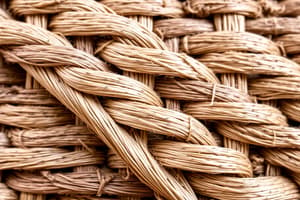Podcast
Questions and Answers
What principle of textile design involves focusing attention on a specific area or element?
What principle of textile design involves focusing attention on a specific area or element?
- Repetition
- Balance
- Emphasis (correct)
- Contrast
Which method of fabric construction involves interlacing two sets of yarns?
Which method of fabric construction involves interlacing two sets of yarns?
- Knitting
- Printing
- Crocheting
- Weaving (correct)
Which textile design principle is primarily concerned with the interaction of different colors?
Which textile design principle is primarily concerned with the interaction of different colors?
- Pattern
- Texture
- Color Theory (correct)
- Scale and Proportion
Which fabric construction method is most associated with reusing elements like colors and shapes to create unity?
Which fabric construction method is most associated with reusing elements like colors and shapes to create unity?
What is a common characteristic of non-woven fabrics?
What is a common characteristic of non-woven fabrics?
Which method applies color patterns onto fabric and includes techniques like screen printing?
Which method applies color patterns onto fabric and includes techniques like screen printing?
Flashcards are hidden until you start studying
Study Notes
Textile Design Principles
- Balance: Achieving visual stability through symmetrical or asymmetrical arrangements.
- Contrast: Utilizing differences in color, texture, and patterns to highlight elements.
- Emphasis: Focusing attention on a specific area or element within the textile.
- Repetition: Reusing elements like colors, shapes, or patterns to create unity.
- Scale and Proportion: Adjusting sizes of patterns and elements for visual harmony.
- Color Theory: Understanding how colors interact, including complementary and analogous schemes.
- Texture: Incorporating physical feel and appearance, influencing the textile's look and use.
- Pattern: Creating repetition of motifs that can be geometric, floral, abstract, etc.
- Movement: Designing elements that guide the viewer’s eye throughout the textile.
Fabric Construction Methods
- Weaving: Interlacing two sets of yarns (warp and weft) on a loom.
- Types: Plain, twill, satin weaves.
- Knitting: Interlocking loops of yarn using needles.
- Types: Warp knit (e.g., tricot), weft knit (e.g., jersey).
- Crocheting: Using a hooked needle to create a fabric by pulling yarn through loops.
- Non-woven Fabrics: Bonding fibers together through methods like heat, chemicals, or felting.
- Applications: Interfacing, insulation, disposable products.
- Printing: Applying color patterns onto fabric using techniques like screen printing or digital printing.
- Embellishment: Adding decorative elements such as embroidery, appliqué, or sequins to enhance fabric design.
Textile Design Principles
- Balance: Visual stability achieved through either symmetrical or asymmetrical arrangements, contributing to overall aesthetic appeal.
- Contrast: Differences in color, texture, and patterns are utilized to accentuate certain design elements, enhancing visual interest.
- Emphasis: Specific areas or elements within the textile are highlighted, drawing the viewer’s focus strategically.
- Repetition: Reusing colors, shapes, or patterns fosters a sense of unity and cohesiveness within the design.
- Scale and Proportion: Adjustments in the sizes of patterns and elements ensure visual harmony and suitability for the intended fabric use.
- Color Theory: Essential for understanding interactions between colors, including concepts of complementary (opposite) and analogous (similar) color schemes.
- Texture: Physical feel and appearance of the fabric play a crucial role in influencing its overall look and how it is perceived by touch.
- Pattern: Creation of motif repetitions can be geometric, floral, or abstract, serving as a fundamental element in fabric design.
- Movement: Design elements guide the viewer's eye across the textile, enhancing engagement and storytelling through the fabric.
Fabric Construction Methods
- Weaving: Involves interlacing warp and weft yarns on a loom, creating various fabric types:
- Plain Weave: Simple, basic pattern with uniform texture.
- Twill Weave: Characterized by diagonal lines, offering durability.
- Satin Weave: Smooth surface with a high sheen, often used in luxurious fabrics.
- Knitting: Interlocking loops of yarn, which can be categorized into:
- Warp Knit: Fabrics created by knitting along the length (e.g., tricot).
- Weft Knit: Fabrics produced by knitting from side to side (e.g., jersey).
- Crocheting: Using a hooked needle, this method produces fabric through loops pulled through each other, resulting in unique patterns and textures.
- Non-woven Fabrics: Created by bonding fibers through methods such as heat, chemicals, or felting. Common applications include interfacing, insulation materials, and disposable items.
- Printing: Techniques such as screen printing and digital printing allow for the application of color patterns onto fabric, enhancing design customization.
- Embellishment: Decorative additions such as embroidery, appliqué, or sequins enhance the fabric's design and aesthetic appeal, adding texture and visual interest.
Studying That Suits You
Use AI to generate personalized quizzes and flashcards to suit your learning preferences.




